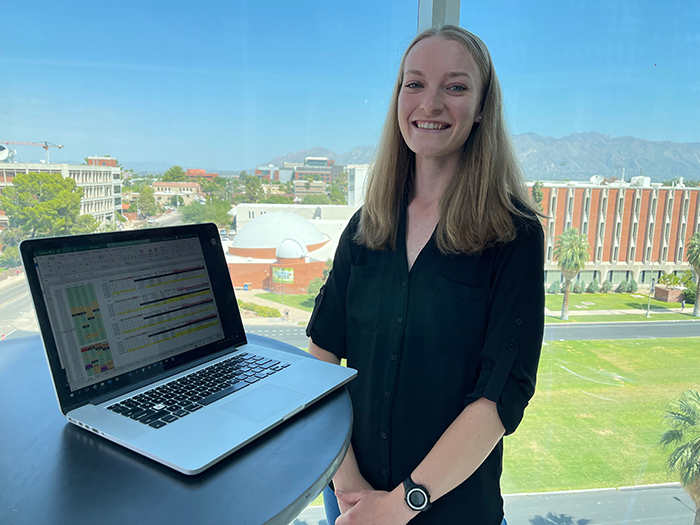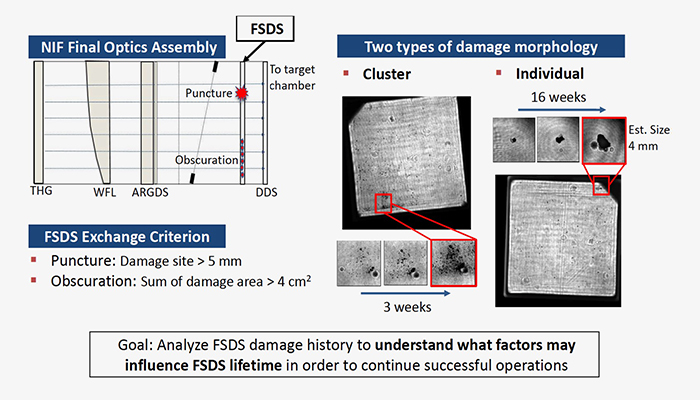Summer Scholar Intern Pursues Her Passion for Optics
November 17, 2021
 Natalie Shultz has been a NIF&PS Summer Scholar for the past two summers. Her project focused on fused silica debris shields (FSDS) used in the NIF final optics assembly. Credit: Natalie Shultz
Natalie Shultz has been a NIF&PS Summer Scholar for the past two summers. Her project focused on fused silica debris shields (FSDS) used in the NIF final optics assembly. Credit: Natalie Shultz Natalie Shultz, a NIF&PS Summer Scholar Program intern for the past two years, discovered her passion—optics—in a high school physics class. And she’s made it the centerpiece of her studies.
“There was a section on optics, and I was enthralled with every topic and experiment that we did,” recalled Shultz, who received a bachelor’s degree in optical engineering from the University of Arizona in May. Shultz is now studying for her Ph.D. in optical sciences at Arizona.
“A particular lab experiment I remember doing was measuring the diameter of a human hair using the diffraction pattern of laser light,” she said. “This opened my eyes to how light could be used to solve complex problems, and since then, I’ve wanted to find new ways to use light to tackle more challenging tasks.”
Her LLNL project over the past two summers focused on fused silica debris shields (FSDS), which are used in the NIF final optics assembly. The FSDS helps mitigate damage to other valuable optics within the final assembly, but the FSDS itself becomes damaged and eventually needs to be replaced.
“We want the FSDS to protect other optics while also maximizing its lifetime, so knowing when to pull an FSDS is crucial,” Shultz said.
Weekly inspections are conducted using online imaging and machine learning to inspect the damage of an FSDS, and tools are used to count the number of damage sites and estimate the size of the damage while an FSDS is in the beamline.
“Last summer, my work was developing a metric for when an FSDS should be pulled,” she said. “This looked at a tool within the weekly inspections that indicates how probable it is that an identified damage site is actually damaged, rather than something like an imaging artifact.
“I was lucky enough to continue my internship over the school year last year and worked on constructing a user interface that could be used to conduct weekly inspections in a more organized and comprehensive manner,” Shultz continued.
 NIF&PS Summer Scholar Natalie Shultz’s project, titled “FSDS Lifetime Forensics,” analyzed data from fused silica debris shields and found two distinct damage morphologies—smaller damage sites that are closer together, called “cluster” damage, and other large, isolated damage sites called “individual” damage. Credit: Natalie Shultz
NIF&PS Summer Scholar Natalie Shultz’s project, titled “FSDS Lifetime Forensics,” analyzed data from fused silica debris shields and found two distinct damage morphologies—smaller damage sites that are closer together, called “cluster” damage, and other large, isolated damage sites called “individual” damage. Credit: Natalie Shultz This past summer, she got to analyze the data from FSDS’s that had been installed over the past year. What she found were distinct damage morphologies, as shown in the figure.
NIF recently completed a pilot FSDS deployment, successfully installing the new optic on 48 of NIF’s 192 beamlines. The optic mitigates much of the debris-induced damage on the grating debris shield (GDS) final optic, reducing damage initiation rate by more than 100 times. This also reduces the overall optics loop burden, enabling additional or more cost-effective optics use for NIF shots.
The pilot demonstration was hailed as an important step toward the Final Optics Debris Management scope outlined in a recent NIF Sustainability Plan to maintain NIF at full capability in the coming years.
Shultz praised NIF&PS physicist Zhi Liao, who mentored her during the past two summers.
“Zhi made sure the work I was doing was interesting to me and beneficial for my future,” she said. “He was always available when I had questions or got stuck and made me excited to start work every day. Something I admire about Zhi is his attitude of learning and to keep moving forward with the knowledge that you gain.”
Liao returned the compliment about Shultz’s work.
“After developing the lifetime inspection metrics for the newest optics on NIF (the FSDS), Natalie helped to analyze the data collected on about 100 FSDS that have been exchanged over the course of the year,” Liao said. “Her analysis helped the team understand the trends of the FSDS lifetime and gave us clues on how we might proceed in the near future. She did an excellent job and her project was very impactful for NIF.
“I think it’s a combination of her technical competence and her willingness to tackle any problem, even ones she doesn’t have experience with,” he said. “Her willingness to learn and to try out new experience is what stands out to me. This openness and flexibility will serve her well in her future endeavors.”
Shultz also singled out the Optics & Materials Science & Technology Damage and Mitigation Group as well as other Lab staff members. “I was able to give several presentations to the group and everyone was always encouraging about the work I was sharing and made me feel like I had a significant contribution,” she said.
“During my first summer, I was amazed with the Lab culture,” she added. “There seemed to be an atmosphere of collaboration and teamwork that was great to be part of. I enjoyed contributing to the Lab mission and learning about the Lab values. I really saw the values come alive in the people that I had a chance to get to know and even those that I briefly interacted with.”
Shultz said she “couldn’t have asked for a better experience with the NIF&PS Summer Scholar Program,” and enjoyed the seminars and talks offered to interns as a “great way to see what was going on at the Lab outside of my own project.”
She was disappointed, however, that the Summer Scholar Program was held virtually for a second year because of the pandemic.
“The first summer being virtual made the transition to continuing through the school year pretty seamless, so that was an advantage,” she said. “But overall, not being able to see all of the facilities and interacting with everyone was definitely a drawback.”
Still, her experiences at NIF make Shultz want to continuing pursuing her passion for optics.
“I would like to conduct research related to how material properties of optical components and systems can be understood, manipulated, and implemented to improve optical capabilities and performance,” she said. “I would also like to return to academia as a professor, so that I can share my passion for optics with future engineers and scientists.”
—Jon Kawamoto
Follow us on Twitter: @lasers_llnl



